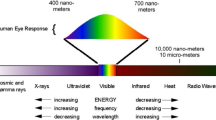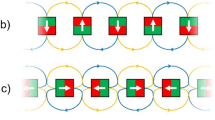Abstract
Metallic magnetic calorimeters (MMCs) are particle detectors that combine ultra-high energy resolution with a predictable and smooth response based on the physics of paramagnetism. For best energy resolution, MMCs are read out with dc SQUID preamplifiers. Since the ac Josephson effect also makes dc SQUIDs broadband RF sources in the 1–100 GHz range, the SQUID can potentially excite RF modes of the MMC sensor, with negative consequences. The importance of this possibility is magnified in direct-coupled MMCs, where the MMC sensor is part of the SQUID loop to maximize performance. For these reasons, the RF behavior of MMC sensors must be investigated. In this report, we present the results of exploratory RF simulations of MMC sensor modes and damping, and we assess three approaches to damp the parallel-meander direct-coupled MMC without excessive noise increase.




Similar content being viewed by others
References
A. Fleischmann, C. Enss, G. Seidel, in Metallic Magnetic Calorimeters, ed. by C. Enss, K. Irwin. Cryogenic Particle Detection. Topics Appl. Phys., Vol 99. (Springer, Berlin) https://doi.org/10.1007/10933596_4
A. Fleischmann et al., AIP Conf. Proc. 1185, 571 (2009). https://doi.org/10.1063/1.3292407
S. Kempf, A. Fleischmann, L. Gastaldo, C. Enss, J. Low Temp. Phys. 193, 365 (2018). https://doi.org/10.1007/s10909-018-1891-6
T. Sikorsky et al., Phys. Rev. Lett. 125, 142503 (2020). https://doi.org/10.1103/PhysRevLett.125.142503
C.R. Bates et al., Appl. Phys. Lett. 109, 023513 (2016). https://doi.org/10.1063/1.4958699
J. Clarke, A.I. Braginski (eds.), The SQUID Handbook: Fundamentals and Technology of SQUIDs and SQUID Systems, (Wiley-VCH, 2004). ISBN-13: 978–3527402298
S.T.P. Boyd et al., J. Low Temp. Phys. 199, 681–687 (2020). https://doi.org/10.1007/s10909-020-02406-5
M. Krantz et al., IEEE Intl. Supercond. Electr. Conf. (ISEC) 2019, 1 (2019). https://doi.org/10.1109/ISEC46533.2019.8990913
M. Krantz, Ph.D. Dissertation, University of Heidelberg, Germany, (2020). DOI: https://doi.org/10.11588/heidok.00028776
COMSOL Multiphysics® v.5.6. http://www.comsol.com. COMSOL AB, Stockholm, Sweden
H.B. Callen, T.A. Welton, Irreversibility and generalized noise. Phys. Rev. 83, 34–40 (1951). https://doi.org/10.1103/PhysRev.83.34
D.M. Pozar, Microwave Engineering, 4th edn. (Wiley, Hoboken, NJ, 2012). (ISBN-13: 978-0470631553)
Acknowledgements
This work was funded by the National Nuclear Security Administration of the Department of Energy, Office of International Nuclear Safeguards. It was performed under the auspices of the U.S. DOE by LLNL under Contract No. DE-AC52-07NA27344. • Data used in this work will be made available upon reasonable request. • LLNL-JRNL-828692
Author information
Authors and Affiliations
Corresponding author
Additional information
Publisher's Note
Springer Nature remains neutral with regard to jurisdictional claims in published maps and institutional affiliations.
Rights and permissions
About this article
Cite this article
Boyd, S.T.P., Kim, GB. & Friedrich, S. Radio-Frequency Resonances and Damping in Metallic Magnetic Calorimeter Sensors. J Low Temp Phys 209, 534–539 (2022). https://doi.org/10.1007/s10909-022-02790-0
Received:
Accepted:
Published:
Issue Date:
DOI: https://doi.org/10.1007/s10909-022-02790-0




